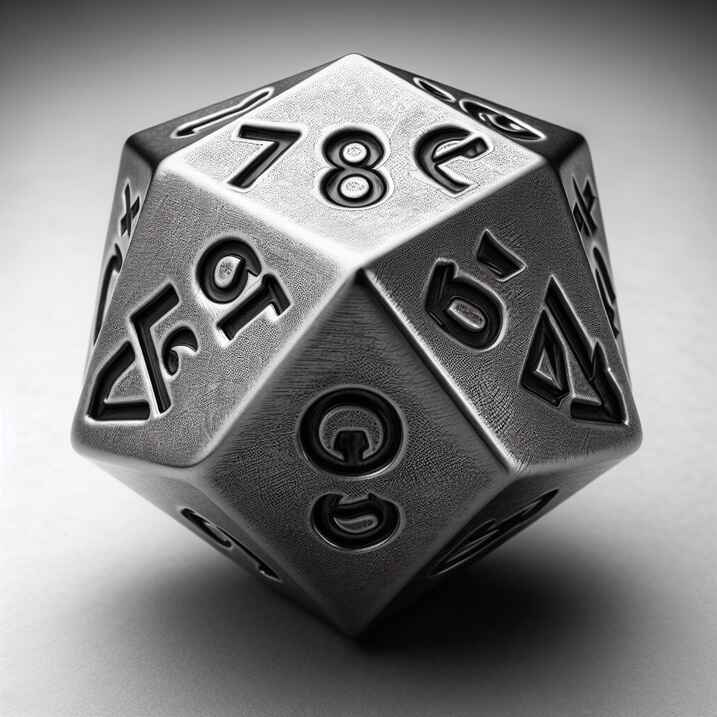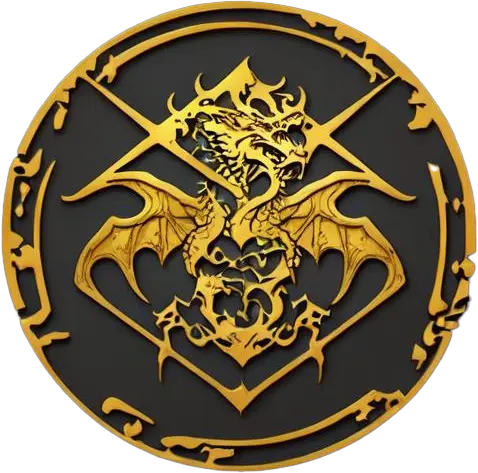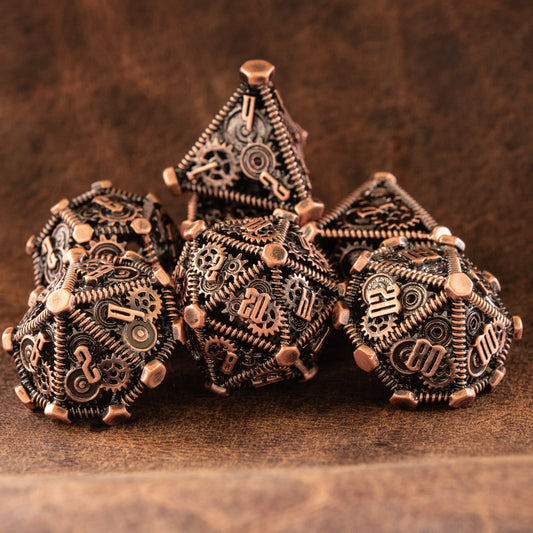
Understanding DnD Dice: How Many Sides and Their Uses
Share
Understanding DnD Dice: How Many Sides and Their Uses
Introduction
In the realm of tabletop role-playing games, Dungeons & Dragons (DnD) stands as a titan. One of the most thrilling aspects of DnD is the element of chance, brought to life through the roll of the dice. These multifaceted dice are not just tools; they are harbingers of fate, determining the success of daring deeds and the failure of perilous plans. The question often arises: "DnD dice, how many sides do they have?" Let's delve into the world of DnD dice and uncover their secrets.
The Role of the d20 in DnD
Critical Successes and Failures
The d20, or twenty-sided dice, is the cornerstone of DnD gameplay. Rolling a natural 20 is akin to hitting the jackpot—it's a critical success, often resulting in double damage or extraordinary feats. Conversely, rolling a natural 1 can spell disaster, leading to critical failures with comical or catastrophic consequences. This duality adds a layer of suspense and excitement to every roll.
Description
The d20, an icosahedron, boasts twenty triangular faces. Each face is numbered from 1 to 20, and its shape allows it to roll smoothly, adding an element of unpredictability to each throw.
Primary Uses
The d20 is indispensable in DnD. It's used for attack rolls, skill checks, and saving throws. Whether you're attempting to strike a fearsome dragon or trying to decipher an ancient rune, the d20 is your go-to dice.
The Standard Set of DnD Dice
Overview
A standard set of DnD dice includes seven different types, each with a unique role. These dice are essential for various aspects of gameplay, from determining damage to calculating spell effects.
d10 (Ten-Sided Dice)
Description
The d10, or pentagonal trapezohedron, features ten faces numbered from 0 to 9. Its distinct shape sets it apart from other polyhedral dice.
Uses
The d10 is versatile, used primarily for damage rolls. When combined with another d10, it forms percentile dice, crucial for rolls that require a number between 1 and 100.
d4 (Four-Sided Dice)
Description
The d4, shaped like a pyramid or tetrahedron, has four triangular faces. Each face is numbered from 1 to 4.
Uses
The d4 is typically used for determining small damage values, such as those from minor spells or weapons. It's also used to calculate the effects of certain potions.
d6 (Six-Sided Dice)
Description
The d6, a familiar cube, has six faces numbered from 1 to 6. Its shape is well-known from traditional board games.
Uses
In DnD, the d6 is used for calculating damage from common weapons and spells. It's also employed in generating character stats during creation.
d8 (Eight-Sided Dice)
Description
The d8, an octahedron, features eight triangular faces. Each face is numbered from 1 to 8.
Uses
The d8 is used to determine damage for larger weapons and abilities, making it a staple in a warrior's arsenal.
Additional Insights
Dice in DnD are more than just random number generators; they are integral to the storytelling and mechanics of the game. Understanding the different types of dice and their uses can enhance your gameplay experience, bringing depth and excitement to every roll. Whether you're a seasoned dungeon master or a novice adventurer, mastering the art of the dice is key to unlocking the full potential of DnD.
Additional Dice in DnD
Percentile Dice (d100)
Description
The percentile dice, often referred to as the d100, is a unique and somewhat mystical element in the DnD dice arsenal. This set consists of two ten-sided dice (d10s), one marked with single digits (0-9) and the other with double digits (00-90). When rolled together, they generate a number between 1 and 100, providing a broad spectrum of possibilities that can influence the game in unexpected ways.
Uses
Percentile dice are indispensable for scenarios that require a high degree of randomness and granularity. Dungeon Masters (DMs) frequently use percentile rolls for determining random loot, magical effects, or the likelihood of encountering rare creatures. For instance, when a rogue searches for hidden treasures, a percentile roll might determine the rarity and value of the discovered items. Similarly, certain spells and effects, like a wild magic surge, rely on these rolls to produce a wide array of potential outcomes.
d12 (Twelve-Sided Dice)
Description
The d12, or dodecahedron, is a twelve-sided die that stands out with its almost spherical shape. Each face of the d12 is a regular pentagon, numbered from 1 to 12. Its design allows for a smooth roll, ensuring a fair distribution of outcomes.
Uses
Despite being less frequently used than other dice, the d12 plays a crucial role in specific contexts. It is primarily utilized for calculating damage from heavy weapons, such as a barbarian's greataxe or a paladin's lance. Additionally, the d12 is employed in certain spell effects that deal substantial damage, making it a favorite among players who relish the thrill of high-risk, high-reward scenarios.
Practical Tips for DnD Players
Choosing the Right Dice
Selecting the perfect set of dice is a personal journey for every DnD player. Consider the following factors:
- Material and Weight: Metal dice offer a satisfying heft, while plastic dice are lighter and often more affordable.
- Design and Readability: Choose dice with clear, legible numbers. Intricate designs can be beautiful but may be harder to read in the heat of battle.
- Quantity: Having multiple sets can speed up gameplay, especially for spells or abilities requiring numerous rolls.
Dice Etiquette
Respecting dice etiquette is essential for a smooth and enjoyable game session:
- Ask Before Borrowing: Always request permission before using another player's dice.
- Roll in a Designated Area: Use a dice tray or a clear space on the table to prevent dice from scattering and disrupting the game.
- Avoid Superstitions: While it's fun to have "lucky" dice, respect other players' beliefs and preferences regarding their own dice.
Rolling Techniques
Mastering your rolling technique can enhance fairness and consistency:
- Shake Well: Ensure a good mix before rolling to avoid predictable outcomes.
- Roll with a Flick: Use a gentle flick of the wrist to roll the dice, ensuring they tumble and produce a random result.
- Use a Dice Tower: For added randomness and spectacle, consider using a dice tower.
The Evolution of DnD Dice
Historical Background
The history of DnD dice is as rich and varied as the game itself. In the early days, Gary Gygax, one of the co-creators of Dungeons & Dragons, sought dice that could introduce a higher level of randomness and excitement compared to traditional six-sided dice. He settled on polyhedral dice, drawing inspiration from ancient games and mathematical principles. These dice, with their diverse shapes and sides, became a cornerstone of the game's mechanics and storytelling.
Modern Variations
As Dungeons & Dragons has evolved, so too has the variety of dice available to players. Beyond the standard set, modern editions and custom rule sets have introduced additional dice types, such as the d30 and the d1000. These specialized dice cater to niche scenarios and offer unique gameplay experiences. For example, a d30 might be used in homebrew campaigns for unique random events, while a d1000 could determine outcomes with extreme precision in complex scenarios.
Dice are the heartbeat of Dungeons & Dragons, bringing chance, excitement, and unpredictability to every game. From the ubiquitous d20 to the specialized d100, each die serves a unique purpose, enriching the gameplay and storytelling. As you embark on your next adventure, armed with your newfound knowledge of DnD dice, remember that every roll tells a story. Embrace the uncertainty, savor the critical successes, and learn from the failures. Gather your dice, rally your party, and let the adventures unfold.
Ready to roll? Share your most memorable dice moments in the comments below, and don't forget to check out our other articles for more tips and insights into the world of Dungeons & Dragons!


